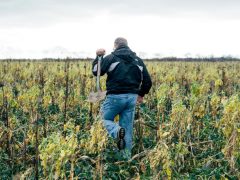Cover Crops, a Farming Revolution With Deep Roots in the Past
Cover Crops, a Farming Revolution With Deep Roots in the Past
February 9, 2016
"When Mark Anson came home with his hair on fire after a seminar on the seemingly soporific topic of soil health, his younger brother, Doug, was skeptical.
What had Mark lit up was cover crops: fields of noncash crops like hairy vetch and cereal rye that act on soil like a nourishing facial after the harvest.
Mark, 60, and his two brothers, together with assorted sons and sons-in-law, run Anson Farms, a big commercial soybean and corn operation in Indiana and Illinois. Concern about the soil quality of the family’s fields had nagged at him for some time. “Our corn was wilting when temperatures hit 103 degrees,” he said, and such heat isn’t so unusual in the summer. “I felt like I had a gorilla on my shoulder.” What he learned about the benefits of cover crops gave him hope.
But to Doug, planting some noncommercial crops seemed an antiquated practice, like using a horse-drawn plow. Cover crops had long been replaced by fertilizers. Still, he shared his brother’s concern about their soil. Its texture was different, not as loamy as it had once been, and a lot of it was running off into ditches and other waterways when it rained. So in 2010 the family decided to humor Mark by sowing some 1,200 acres, which Mark describes as highly eroded farmland, with wheat cleanings and cereal rye. Additionally, they spread some cover crops to eroded areas in a few fields.
The next spring, Doug had to admit that the soil texture on that strip was better. And the water that ran off it during a rainstorm was clear, a sign that the roots of the cover crops were anchoring valuable topsoil in place.
But Doug didn’t become a believer until 2013, when the family was grappling with a terrible drought. “In the part of a field where we had planted cover crops, we were getting 20 to 25 bushels of corn more per acre than in places where no cover crops had been planted,” he said. “That showed me it made financial sense to do this.”
Now some 13,000 of the 20,000 acres that the family farms across nine counties are planted with cover crops after harvesting, and farmers around them are beginning to embrace the practice."
